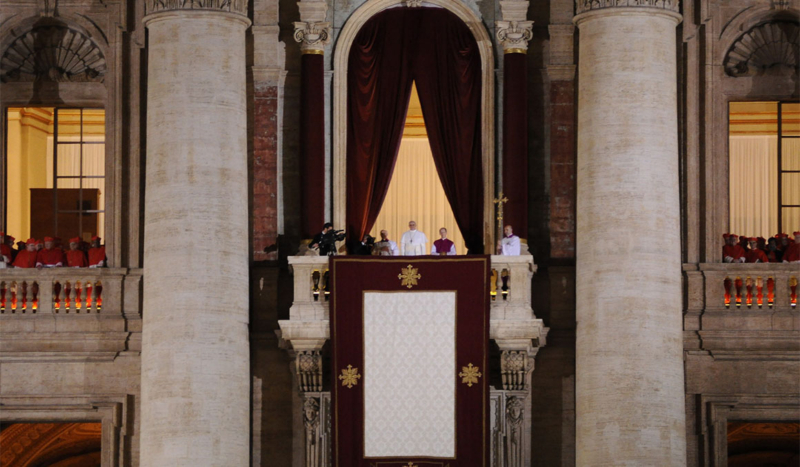
Pope Francis, March 13, 2013, photo taken from St. Peter's Square, just after the pope's election / Tenan
CV NEWS FEED // As the Catholic Church begins the sacred task of choosing a new pope, this guide provides a clear overview of key terms surrounding the upcoming conclave. Whether you have experienced multiple papal transitions or you’re new to these traditions, this glossary will help deepen your understanding of this pivotal moment in Church history.
Camerlengo
The cardinal who oversees the Church’s temporal affairs during sede vacante (see definition below). He officially confirms the pope’s death and secures the papal apartments. Cardinal Kevin Farrell, an Irish cardinal appointed by Pope Francis in 2019, currently serves in this role.
College of Cardinals
The senior clergy appointed by the pope. Cardinals under the age of 80 are eligible to vote in the conclave.
Conclave
Latin: cum clave or “with a key.” The solemn and secret gathering in the Sistine Chapel of eligible cardinals who will elect the next pope. The cardinals remain secluded until they reach a decision. For more information on this term, see CatholicVote’s “Inside the conclave” background story.
Dean of the College of Cardinals
The most senior Cardinal Bishop in the College of Cardinals, currently Cardinal Giovanni Battista Re. During a conclave, he presides over the meetings of the cardinals and plays a key role in the funeral of a pope and the start of the conclave. If he is under 80, he also presides over the election process unless he is not eligible to vote.
Domus Sanctae Marthae (Domus Santa Marta)
The guesthouse in Vatican City where cardinals stay during a conclave. Pope John Paul II established this lodging to provide better accommodations for the electors than those in the past.
Extra Omnes: “Everyone out!”
This command is issued to clear the Sistine Chapel of all non-electors just before voting begins, ushering in the solemnity and secrecy of the conclave.
Fumata: “smoke”
The smoke rises from a special chimney atop the Sistine Chapel and signals the vote outcome to the world. Fumata nera (black smoke) means that no pope has been elected, and fumata bianca (white smoke) means a new pope has been chosen.
Habemus Papam: “We have a pope!”
The Cardinal Protodeacon proclaims this joyous Latin announcement from the balcony of St. Peter’s Basilica when a new pope is elected.
Infirmarii: “infirmary”
Cardinals appointed to bring ballots to any electors who are too sick to attend the voting in the Sistine Chapel. Their role ensures that all cardinal electors can participate, even if they are physically incapacitated.
Novemdiales
Nine days of prayer and mourning after the death of a pope. CatholicVote gives more details about this period of prayer before the conclave here.
Papal Bull
An official document issued by the pope. The conclave is governed by Universi Dominici Gregis (1996), which was issued by St. John Paul II and amended by Pope Benedict XVI and Pope Francis.
Papal Name
The name chosen by the new pope upon his election, symbolizing his spiritual identity and mission. Often reflects continuity with past papacies or saints.
Revisers
A group of cardinals (usually three) tasked with checking the accuracy and integrity of the vote count after each scrutiny. They help verify that the conclave follows proper procedures.
Rogito
The official document summarizing the events of the conclave and the election of the pope. It is drawn up by the notaries and signed by those who witnessed the election.
Scrutineers
Also called scrutatores, these are three cardinals chosen by lot for each round of voting. They collect, open, and count the ballots, ensuring the election process follows established rules.
Scrutiny
The formal voting process used in the conclave. Each cardinal elector writes his choice for pope on a paper ballot. The ballots are read aloud and counted.
Sede Vacante: “Vacant seat”
The period between the pope’s death or resignation and the election of his successor. Liturgical and administrative changes mark this unique time in the Church.
Sistine Chapel
The historic chapel within the Apostolic Palace where the conclave is held. Famous for Michelangelo’s frescoes, it is the most sacred decision-making chamber in the world.
Universi Dominici Gregis: “the Lord’s whole flock”
Pope John Paul II’s Apostolic Constitution from 1996 (with later amendments by Pope Benedict XVI and Pope Francis) that outlines the procedures for the papal conclave, including the election of the pope, the duties of cardinals, and the regulations surrounding the voting process.
Urbi et Orbi: “To the City [of Rome] and to the World”
The first apostolic blessing offered by the newly elected pope, addressing Catholics everywhere.
>> Inside the conclave: Learn more about the Church’s ancient process for electing popes <<

